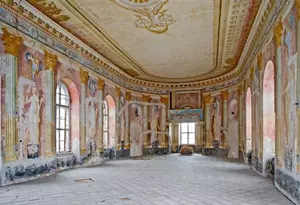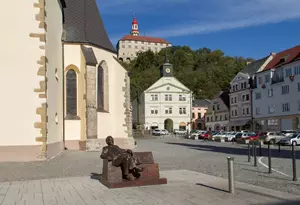Embracing Italian Nobility

The Italian noble families that settled in our region played a vital role in enhancing various fields such as architecture, painting, music, and literature. Their influence was particularly strong during the Renaissance and Baroque eras, a time when they introduced fresh artistic styles and techniques to the Czech lands. Notable noble families like the Piccolomini, Colloredo-Mannsfeld, and Collalto made substantial contributions to the cultural landscape, and their legacies can still be seen in many monuments today.
Collalts

Colloreds

Piccolomini

Architectural influences
The Italian Renaissance profoundly impacted architecture in the Czech lands. Numerous castles and palaces were constructed or remodeled following Italian models. A prime example is the castle in Uherčice, one of the main focuses of this year’s project, celebrated for its Renaissance architecture featuring Italian influence. Other notable structures influenced by Italian architecture include the castles in Opočno and Náchod.
Painting, sculpture, music, and literature
Italian artists and their contributions had a significant impact on Czech painting and sculpture. Many of these artists were commissioned by Italian nobles to create remarkable works of art on their estates. Music and literature were other fields where Italian nobles introduced fresh ideas and traditions. For instance, Baroque music was heavily influenced by Italian composers who worked within Bohemian courts. Similarly, works of literature from this era frequently mirrored Italian stylistic elements and themes.
This year’s project highlights the state castles of Uherčice, Opočno, and Náchod, all renowned for their historical and artistic significance, representing essential examples of Italian influence.
Chateau Uherčice
Uherčice Castle exemplifies Renaissance architecture with Italian influences and has a history dating back to the 16th century when it was remodeled based on Renaissance designs. The castle is particularly famous for its stunning garden and interiors that showcase Italian artistic influences.
Opočno Castle
Opočno Castle is another significant site in this year’s project. This castle, which has undergone multiple reconstructions, illustrates the impact of Italian architecture and art. Its rich history coupled with its remarkable works of art makes the castle one of the most important monuments in the Czech lands.
Náchod Castle
Náchod Castle is the third key focus of the project. With origins dating back to the 13th century, this castle displays strong influences from both the Italian Renaissance and Baroque periods. Known for its beautiful interiors and gardens, it reflects a rich Italian artistic heritage.
In the Footsteps of Noble Families: Italian Nobility in the Czech Republic
Project Overview
-
Name: In the Footsteps of Noble Families
-
Organizer: National Heritage Institute
-
Duration: Yearlong cultural and heritage initiative
Focus for 2025
-
Theme: Impact of Italian nobility on Czech art and culture
-
Historical Span: 16th to 18th century
Key Elements of the Project
-
Exhibitions and Lectures:
-
Showcasing cultural heritage and artistic influences
-
-
Cultural Events:
-
Various events designed to engage a wider audience
-
Significant Noble Families Highlighted
-
Families:
-
Piccolomini
-
Colloredo-Mannsfeld
-
Collalto
-
Notable Site
-
Uherčice Castle:
-
Recognized for its Renaissance architectural features and Italian influences
-
A key location for the 2025 project
-





